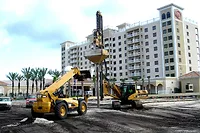Mid-year Construction/Contracting Outlook
Many people believe a large drop in the stock market, a significant decline in economic output or high unemployment means we are in a recession. But who officially determines when the U.S. economy is in a recession?
The federal government collects an enormous amount of economic and financial statistics. So, does anyone at the federal government level make this decision? No, the president and Congress have nothing to do with it. How about this quasi-government institution called the Federal Reserve (Fed), led by chairman Alan Greenspan? No again. The Fed has a large arsenal of weapons to stop a recession, and some people believe it can start one too; but no. Give up? The Business Cycle dating Committee of the National Bureau of Economic Research (NBER), an economic think tank, decides whether we are in recession by evaluating economic indicators.
Should we send this question to Regis? Many millionaires or billionaires probably would not know the answer. The NBER does not define a recession as a decline in two consecutive quarters in real gross domestic product (GDP - the value of all goods and services produced in the United States, corrected for inflation). Instead, a recession is "a significant decline in activity spread across the economy, lasting more than a few months, visible in industrial production, employment, real income and trade."
The NBER has dated all U.S. business cycles, including contractions and expansions, since 1857. No business cycle is the same, but since World War II, the typical business cycle has followed a familiar pattern. As the economy expands, demand becomes greater than supply and inflation increases, causing the Fed to raise interest rates to lower demand. As demand begins to fall, businesses cut production, causing the Fed to intervene by reducing interest rates. Eventually, aggregate demand recovers and output expands again.
In the current business cycle, the economy is not in recession, but business activity has slowed. In past recessions, industrial production and employment both declined for extended periods. During the last recession, which began in July 1990 and ended in March 1991, all major economic indicators fell. In 2000 and early 2001, personal income, employment and prices (excluding energy) have all remained stable while industrial production is falling slightly. But using industrial production as a major indicator of economic activity may be misleading. Since the last recession, the service sector has been way ahead of the manufacturing sector in creating jobs. Productivity has increased in all sectors of the economy, so a decline in industrial production really does not tell the whole story. Leading indicators for manufacturers' new orders for non-defense capital goods and materials and consumer goods are increasing this year. This trend implies that both durable and non-durable investment will improve in 2000 and, consequently, real economic growth is sustainable.
Despite warnings of an impending recession, the economic growth in the United States should continue at a moderate pace, although slower than during the late 1990s. While the outlook for the general economy is good, construction will exhibit mixed signals. Residential construction output was lackluster during the first of last year and fell during the second half of 2000. Recent indicators show signs of recovery - housing starts and new home sales are improving with residential mortgage rates approaching recent-memory lows. Nonresidential construction, resembling a roller coaster in 2000, peaked in the early months, fell sharply in the middle months, recovered in the fall and then increased in the later months. In 2001, residential construction should improve while nonresidential construction will have moderate but fluctuating growth. For the present, the general economy, including the construction industry, has dodged the recession bullet.
Growth in private investment, including construction put in place, is vital for sustaining economic growth. Despite impressive private investment growth in the first two quarters of 2000, total investment fell in the third and fourth quarters as consumer and business demand waned. The economy expanded only at a moderate rate due to this investment decline during the final two quarters. In response, the Fed has acted to reduce interest rates this year to stimulate investment, which was critically needed for economic growth. As private investment responds to this monetary stimulation, economic growth will be generated in residential and nonresidential construction beginning this year and continuing into 2002.
The U.S. Department of Commerce reported real GDP accelerated at an astonishing rate of 5 percent in 2000, the fourth consecutive year of real aggregate economic growth above 4 percent. Declining construction expenditures and durable investment purchases are the reasons real GDP growth will be lower this year than in 2000. It's too early to tell how long it will take for interest rate cuts or income tax cuts to have any impact on growth. However, with the Fed's actions, we are moving in the right direction toward improved consumer confidence, combined with a recovery in private investment, higher employment, increasing incomes and stable prices to foster sustainable economic growth.
Looking for a reprint of this article?
From high-res PDFs to custom plaques, order your copy today!



